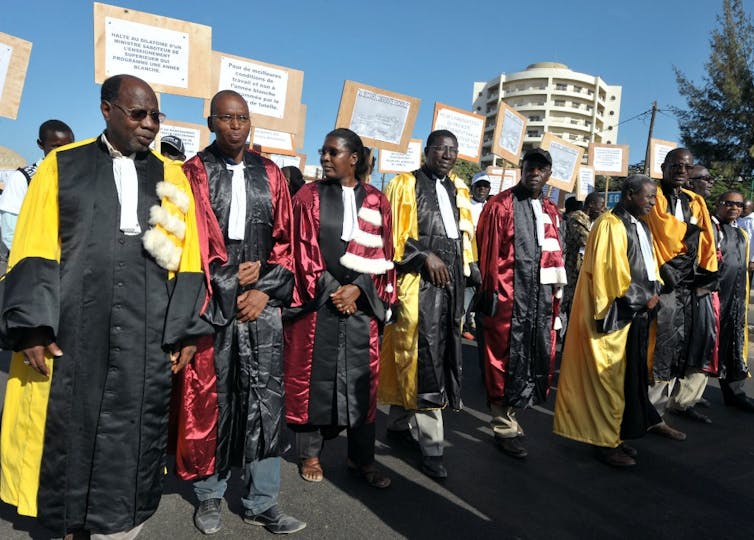Senegalese universities are known to produce high quality graduates and research. But some of these institutions could do more if they were able to overcome major organisational and governance challenges. For instance, some don’t have independence or adequate budgets.
Their difficulties are the result of a combination of factors, including the growth of student numbers from 93,866 in 2012 to 190,145 in 2018. The restructuring of the job market and changes to the legislative, physical and social environments also play a part.
The lack of planning and forward looking policies have taken a heavy toll on public universities. They also affect how well students perform in exams.
Senegal has eight public universities. There are also institutions to provide vocational education, the first of which is already operational in Thiès. Four others were set to open at the start of 2020.
In addition, there are over 300 private universities and educational institutions. These are either founded by local or foreign developers, belong to a transnational network or are a branch of a foreign institution.
Most of the institutions are concentrated in Dakar and in Saint-Louis, Thiès and Ziguinchor. Service sector training is mainly provided through private institutions, while public institutions teach the social sciences and humanities, science and technology and medicine.
Overall, the quality of higher education remains highly eclectic and uneven across locations and disciplines. This poor performance makes public universities less attractive than the growing number of private universities. The government needs to make many reforms to address this.
The challenge of university governance
Public universities in Senegal were founded in the 1960s. Their aim was to develop the country and break away from the colonial model. Some faculties have since attempted to adjust their programmes to suit modern needs, but the economic and political conditions haven’t always been favourable.
Internal governance is sometimes weak, too. The leaders of public universities haven’t always been able to put national reform directives into action. Private universities tend to succeed at this.
In the private university system, the state has a token role, mostly limited to authorising the opening of the university. The way in which private universities are governed allows them to adjust more easily to new training needs.
Public universities have a public service duty, yet they must also deal with national and international competition.
In spite of its willingness to improve the sector and avoid stagnation, the Senegalese government doesn’t govern its universities well.
For instance, the government decided to place all 2019 high school graduates in public universities. This was done without any prior study of the possible effects.
The influence of government, and other local authorities, over university presidents could interfere with the independent management of the university. The activities of staff, in turn, are often determined by presidents. These relationships all have consequences for the proper running of the institution.
Difficulties implementing reforms
Higher education and research policies often undergo reforms, with the aim of improving the system. For instance, the 2013 National Dialogue on the Future of Higher Education resulted in 78 recommendations.

This dialogue covered issues such as programme quality, funding, the job market, internationalisation and innovation. Those heading the dialogue wanted to reorient programmes towards science, technology, engineering and mathematics and coordinate them with the professional world.
Today, in spite of the presidential directives, which instructed universities to align their policies with the dialogue, universities have struggled to consolidate the progress made. Reforms are thwarted by weak governance.
This can be explained by, among other things, weak commitment to the institution from some university leaders, a lack of understanding of student profiles (such as who they are and what they want), and a lack of links with the business world – not only to get students into the workforce but also to fulfil social responsibility.
Towards public-private partnership?
Until 1995 higher education was run exclusively by the state. Today, the government is no longer the sole provider of higher education, but it retains control of the certification process. It also has the decison-making power over whether to admit new graduates from high schools into public universities.
The relationship between private and public institutions has changed from one of “co-existence” to one of competition. Private institutions have a better overall reputation. To remain competitive and generate extra resources for institutional budgets, public universities have started to promote paid programmes and services, such as expert consulting, training and room hire.
But the involvement of productive economic sectors in public universities – courses that align with workforce demand, involvement of business professionals in teaching and serving as board members – remains a real issue.
Some of the changes that universities are experiencing, such as results-oriented management, are quite promising. Others, like the implementation of the Bachelor, Master and PhD reform, are creating even greater difficulties for Senegal, especially since the system is lacking in resources, and in management and governance skills.
To avoid stagnation, Senegalese universities should be allowed to get on with the changes they see as necessary.
They need to clean up their management and involve all stakeholders throughout the transformation process. This is the prerequisite for avoiding stagnation and building high-performance universities.
Translated from the French by Alice Heathwood for Fast ForWord


